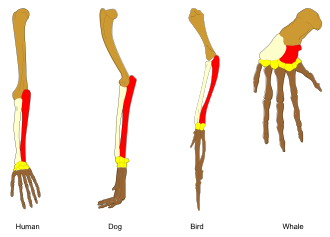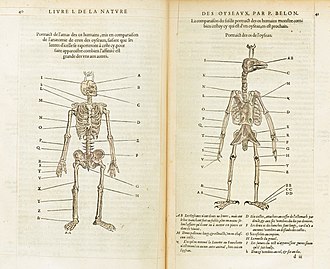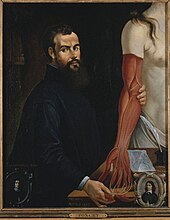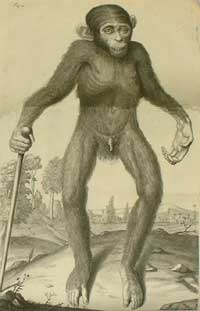Comparative anatomy

Comparative anatomy is the study of similarities and differences in the
of species).The science began in the
Comparative anatomy has provided evidence of common descent, and has assisted in the classification of animals.[2]
History

The first specifically anatomical investigation separate from a surgical or medical procedure is associated by Alcmaeon of Croton.[3] Leonardo da Vinci made notes for a planned anatomical treatise in which he intended to compare the hands of various animals including bears.[4] Pierre Belon, a French naturalist born in 1517, conducted research and held discussions on dolphin embryos as well as the comparisons between the skeletons of birds to the skeletons of humans. His research led to modern comparative anatomy.[5]

Around the same time,
Concepts

Two major concepts of comparative anatomy are:
- whales.
- Analogous structures - structures similar in different organisms because, in convergent evolution, they evolved in a similar environment, rather than were inherited from a recent common ancestor. They usually serve the same or similar purposes. An example is the streamlined torpedo body shape of porpoises and sharks. So even though they evolved from different ancestors, porpoises and sharks developed analogous structures as a result of their evolution in the same aquatic environment. This is known as a homoplasy.[9]
Uses
Comparative anatomy has long served as evidence for evolution, now joined in that role by comparative genomics;[10] it indicates that organisms share a common ancestor.
It also assists scientists in classifying organisms based on similar characteristics of their anatomical structures. A common example of comparative anatomy is the similar bone structures in forelimbs of cats, whales, bats, and humans. All of these appendages consist of the same basic parts; yet, they serve completely different functions. The skeletal parts which form a structure used for swimming, such as a fin, would not be ideal to form a wing, which is better-suited for flight. One explanation for the forelimbs' similar composition is descent with modification. Through random mutations and natural selection, each organism's anatomical structures gradually adapted to suit their respective habitats.[11] The rules for development of special characteristics which differ significantly from general homology were listed by Karl Ernst von Baer as the laws now named after him.
See also
References
- PMID 20182607.
- PMID 25101403.
- S2CID 38940794.
- ^ Bean, Jacob; Stampfle, Felice (1965). Drawings from New York Collections I: The Italian Renaissance. Greenwich, CT: Metropolitan Museum of Art. p. 28.
- S2CID 143961902.
- PMID 26107459.
- ^ Edward Tyson, Orang-Outang..., 1699, p. 59.
- ^ Caldwell R (2006). "Comparative Anatomy: Andreas Vesalius". University of California Museum of Paleontology. Archived from the original on 23 November 2010. Retrieved 17 February 2011.
- ISBN 978-0-07-802302-6.
- PMID 14624258.
- OCLC 1053072597.
Further reading
- Lőw P, Molnár K, Kriska G (2016). Atlas of Animal Anatomy and Histology. Springer. ISBN 978-3-319-25172-1.
- Wake MH, ed. (1979). Hyman's Comparative Vertebrate Anatomy (3rd ed.). University of Chicago Press. ISBN 978-0-226-87013-7.
- Zboray G, Kovács Z, Kriska G, Molnár K, Pálfia Z (2010). Atlas of comparative sectional anatomy of 6 invertebrates and 5 vertebrates. Wien: Springer. p. 295. ISBN 978-3-211-99763-5.


